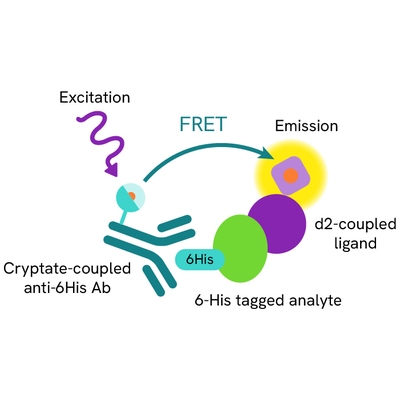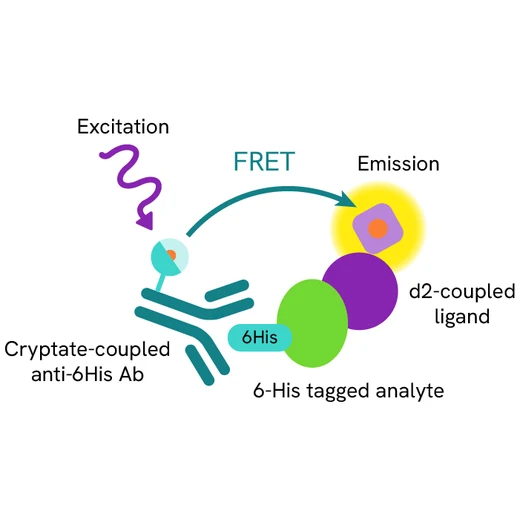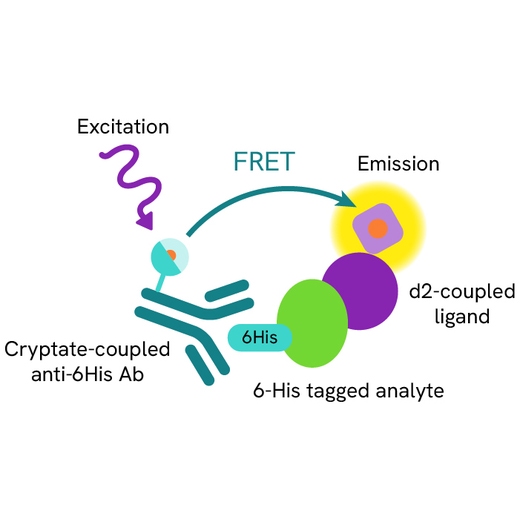

HTRF Human VHL Binding Kit, 500 Assay Points








| Feature | Specification |
|---|---|
| Application | Protein-Protein Interaction |
| Sample Volume | 5 µL |









Product information
Overview
A fast and easy way to identify new binders to VHL protein.
VHL, also known as von Hippel-Lindau, is involved in many biological processes and is closely associated with the regulation of angiogenesis, cell growth, or cell survival.
VHL is one of the most popular E3 ligases recruited by bifunctional Proteolysis-targeting chimeras (PROTACs) to induce ubiquitination and subsequent proteasomal degradation of a targeted protein.
VHL interacts with several proteins to form the functional von Hippel-Lindau ubiquitination complex, in which VHL seems to act as a target recruitment subunit in the E3 ubiquitin ligase complex, and targets various proteins to proteolysis such as the hydroxylated hypoxia-inducible factor (HIF) under normoxic conditions.
Therefore, identifying new PROTAC VHL ligands can improve selective proteasomal-dependent degradation of proteins of interest, involved in the onset of diseases such as cancers.
How it works
Assay principle
The HTRF Human VHL Binding Kit is a competitive assay format which uses a VHL-Red Ligand as VHL ligand, a 6His-tagged human VHL protein complex, and an anti 6His Europium Cryptate-labeled antibody. VHL binding compounds compete with the VHL-Red Ligand and thereby prevent FRET from occurring.

Assay protocol
The VHL binding assay can be run in a 96- or 384-well low volume white plate (20 µL final). As described here, samples or standards are dispensed directly into the assay plate. The 6His-tagged VHL protein complex is then added, followed by the dispensing of the HTRF reagents: The anti 6His antibody labeled with Europium cryptate and the VHL Ligand labeled with a Red HTRF acceptor. The reagents labeled with HTRF fluorophores may be pre-mixed and added in a single dispensing step. No washing steps are needed. The protocol can be further miniaturized or upscaled by simply resizing each addition volume proportionally.

Assay validation
Screening of VHL orthosteric ligands
Two VHL ligands were characterized.
VH-032 (assay standard) and VH-298 display the expected potencies in good correlation with the literature. An irrelevant compound Lenalidomide (Cereblon ligand) does not compete with the VHL-Red Ligand binding, demonstrating the specificity of the HTRF VHL Binding Kit.


Screening of PROTAC compounds (VHL-ligand based)
Four VHL-ligand based PROTAC compounds (CRBN-6-5-5-VHL, TBK1 , CM 11 and ARV-771) were characterized. All compounds display the right pharmacological ranking in good correlation with the literature.


DMSO effect on assay performance
Different percentages of DMSO were tested, from 0.1% to 2% (final in the wells). The results indicate that the assay window is reduced with the increasing percentages of DMSO, while the pharmacology remains stable.

Specifications
| Application |
Protein-Protein Interaction
|
|---|---|
| Automation Compatible |
Yes
|
| Brand |
HTRF
|
| Detection Modality |
HTRF
|
| Product Group |
Kit
|
| Sample Volume |
5 µL
|
| Shipping Conditions |
Shipped in Dry Ice
|
| Target Class |
Binding Assay
|
| Target Species |
Human
|
| Technology |
TR-FRET
|
| Therapeutic Area |
Inflammation
Neuroscience
Oncology & Inflammation
|
| Unit Size |
500 assay points
|
Video gallery
Resources
Are you looking for resources, click on the resource type to explore further.
Uncover protein degradation mechanisms with our no-wash assay platforms
Discover the versatility and precision of Homogeneous Time-Resolved Fluorescence (HTRF) technology. Our HTRF portfolio offers a...
This guide provides you an overview of HTRF applications in several therapeutic areas.
Proteolysis Targeting Chimaeras (PROTACs) are innovative small molecules that revolutionize drug discovery. They consist of two...


Loading...
How can we help you?
We are here to answer your questions.






























